It’s fair to say that we all know a lot more about pandemics and how infections spread across populations than we did five years ago. And while COVID-19 is far better understood now than it was in the early days of the pandemic, there are, unfortunately, other diseases to be concerned about now, including mpox and H5N1. Preparation is all well and good, but what’s the best way to stay one step ahead of a virus that could make a leap to humans?
One answer to that question involves veterinarians. In an article for The New Yorker, Rivka Galchen explored an evolution in the veterinary world: a growing number of doctors are taking a public health approach to animal populations — both for the health of animals and to reduce the risk of a disease mutating and targeting humans.
Among the experts Galchen spoke with for the article is Sally Slavinski, a veterinarian who works for New York City and recalled efforts to vaccinate 500 raccoons in 2009 to address a rabies outbreak. As Slavinski pointed out, there’s already some overlap between veterinary medicine and public health. “Herd health, flock health — that is something we think about all the time, that is part of our training,” she told The New Yorker.
Scientists Think They Know What Will Cause the Next Pandemic
Being ready for a crisis mattersIn a 2021 paper published in the journal Lab Animal, Ellen P. Neff noted the increasing importance of monitoring outbreaks that spread from animals to humans. “[S]pillover does happen — as the current pandemic attests — and the interfaces between human and animals continue to shift and change, bringing novel combinations of species and viruses into contact,” Neff wrote. All of which means that the future of epidemiology may involve monitoring a lot more species.
Whether you’re looking to get into shape, or just get out of a funk, The Charge has got you covered. Sign up for our new wellness newsletter today.



















